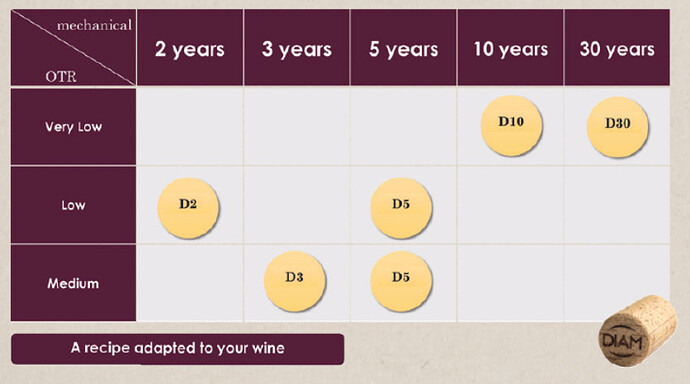William Kelly’s recent Instagram video certainly makes the case for the necessity for some “other-than-airtight” closure to ensure appropriate maturation.
A magnum sidewall is thicker than a 750 so that should have some marginal effect in slowing external temp fluctuations over years and decades from reaching the liquid outer surface. Shouldn’t matter in bottles and mags in a stable external environment though.
I’m curious the types of reactions that don’t depend on oxygen, or proceed with lower concentrations of oxygen, in magnum for longer as compared to 750 leading to a different chemical evolution and concentration and possibly identity of reaction products.
David,
There is no such thing as an airtight seal unless you’re talking an ampule. All screw caps have liners that allow in different amounts of oxygen. All corks allow in varying amounts of oxygen.
Fair enough Larry. I think the point I failed to make was really the rate of oxygen infiltrating the bottle. A bad seal - no matter the material - invariably will expedite the aging process to a point, that if I understood William correctly, prematurely oxidizes a wine. So some oxygen is necessary and good, and moves the wine along a desired developmental track toward full maturation. Better?
And just the increased mass is less likely to fluctuate with temperature swings - granted probably not too big a factor in most settings. I think the general thought is half the air per unit of wine. Anecdotally, it sure seems like magnums age slower - must be something to it!
As far as I remember, the numerical values in DIAM 5, DIAM 10, etc. represent the guarantee that Diam producer gives to the wine producer. It doesn’t have anything to do with oxygen transfer rates or how long the cork will survive.
In similar fashion as with screw caps, in my very limited experience, wines under DIAM show way younger than you expect them to show given their age.
In a time when it’s already problematic to consume our favourite wines because they have to age for 20-30 years, adding on even more years because of the specific closure being used doesn’t seem like a great idea at all. Any change is also difficult because any feedback usually comes many years after the fact, making the whole process slow.
They are absolutely marketing different closures based on permeability.
Diam closures are designed to meet all expectations regarding the evolution of the wine, its varietal expression and duration of conservation. Available in different levels of permeability, they master the oxygen transfer rate and their constancy throughout bottled life.
Although don’t ask me how D5 can have both low and medium OTR.
This. I was always under the impression that age ability came in part as a function of critical mass, though a larger bottle would lead to a slower/better aging curve.
Yes. Thank you William. Just ask Charles Van C. at Hudelot-Noellat about his 10s that were all overfilled. They were wonderful wines but almost every one was a leaker.
I received a Tercero shipment a few months back and one of the bottles was leaking from the closure. It was not temperature related but rather a dent in the Stelvin closure that broke the seal loose. I twisted it tight and put it in the fridge.
I could not disagree more. Screw-caped bottles experience much greater evaporation over time than t-corks.
It seems like something like the DIAM system makes for the best of both worlds. Still allows for some air to get into the wine over time for cellaring wines, still offers the fun aspect of removing a cork, but also doesn’t allow for TCA.
From what I can gather from above the screw top’s main downfall is that it doesn’t allow any air into the wine so can cause wines that are aged to taste young or reductive. I feel like since the differences are so minimal that corks will probably continue to be the choice by most people. If I were in the driver seat of a winery I think I would go with the new age DIAM systems.
This was my experience as well. I was fortunate to taste 4 Willamette Valley Pinot Noirs, each of them bottled under cork and SC. All the wines were in good shape but while the SC wines all seemed you ger, the cork finished wines were the groups unanimous preference.
And here I thought modern screw caps was designed to let in enough oxygen, to have the wines age at a certain pace to mimic corks aging curve… guess not.
Those types of screw cap closures definitely exist, but I haven’t seen anyone using anything much more advanced than your everyday screw cap, and also haven’t seen much discussion about specific bottles and specific closures like we have quite often regarding DIAM or traditional corks.
It could just be my ignorance, perhaps I wouldn’t distinguish between a cheap, regular screw cap and some advanced nano screw cap meant for aging if both of them popped into my eye sockets.
Thousands of auction bottles say otherwise. The failure rate of natural cork is much greater than that of screw tops, and most bottles from 50s, 60s, etc…with pristine fill levels are screw-capped.
Brian,
Please let me know which wine so I can replace if need be. And did it look like it was banged up in transport? Unfortunate - but fortunate for me that this does not happen often…
Cheers
The wine was fine Larry, no worries.
It’s not the screw cap itself - it’s the liner on the inside of the cap that determines OTR . . .
Cheers
Ok - good to hear . . . But sorry about that …
Cheers
